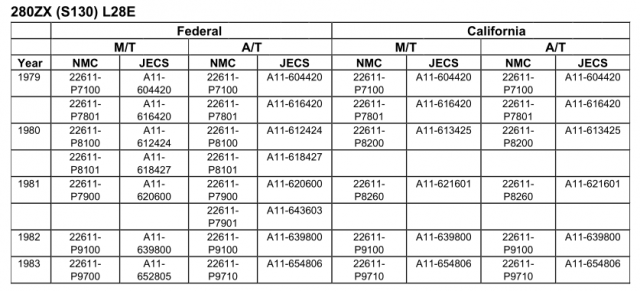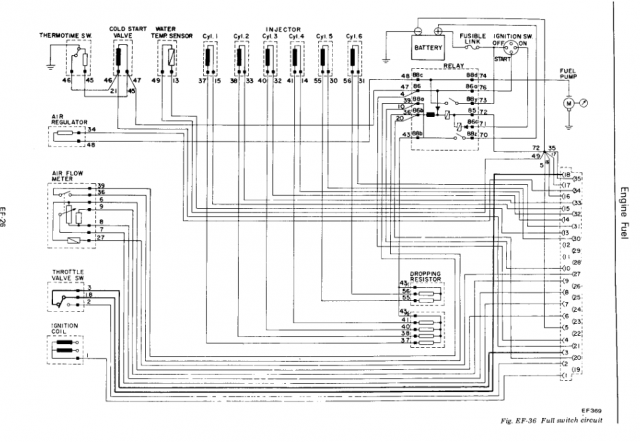
NewZed
Members-
Posts
6698 -
Joined
-
Last visited
-
Days Won
72
Content Type
Profiles
Forums
Blogs
Events
Gallery
Downloads
Store
Everything posted by NewZed
-
ignition Anyone else using FAST EZ EFI? Help
NewZed replied to Shiboh's topic in S130 Series - 280ZX
https://www.diyautotune.com/support/tech/install/chevrolet-gm/carb-to-efi/part1/ https://www.msextra.com/product-range/traditional-megasquirt/ The Megasquirt product range offers from the ‘cheap and cheerful’ batch fire fuel-only in full DIY assembly to full sequential fuel and spark on a V8 with a pre-assembled ECU. -
Compare the ratios to a "normal" 240Z or 280Z. 1st gear is where you'll first notice the ratios. If you live in a hilly area you'll want something around 12:1. If you live in a flat area, with a big torquey engine, maybe 11:1. And, "16 inch" is the diameter of the rim, not the diameter of the wheel. 240Z - 3.592 x 3.364 = 12.0 280Z - 3.321 x 3.54 = 11.75 280ZX - 3.062 x 3.9 = 11.94
-
https://forums.hybridz.org/topic/130570-thoughts-on-apex-engineered-88-subframe/?do=findComment&comment=1221897
-
Put the two distributors side by side and see if you can see the difference. The stator ring , the ring with the spikes, might have an internal adjustment that would affect timing. Also, and you probably should have done this sooner, make sure that the advance mechanism on your new one is not stuck. The vacuum advance moves the breaker plate and the little ball bearings get rusted up. The mechanical advance has springs and weights but also gets gummed up. Be careful with the breaker plate if you try to turn it and it's stuck you can break the bearing cage. Might just be that your new on is stuck in the advanced position. That seems more likely. Either way you want the advance mechanisms to move smoothly.
-
Most "learning" EFI systems take multiple start, warmup, and cool-down/restart cycles before the parameters are properly set. They don't learn everything on the first pass. Rich is safer than lean so I'd expect them to start rich and lean things out based on O2 readings as time goes on. You could just drive it and keep a log and see where things go. Any changes you make will upset the learning process. Even on modern cars, you're supposed to start the engine cold and let it warm up fully, no throttle input, if you reset the computer. It's part of the learning process.
- 5 replies
-
- pcv
- pcv breather valve cover
-
(and 2 more)
Tagged with:
-
Don't know. I know that there's a weaker 5 speed out there that was used on cars like the Datsun B210. You could probably compare parts on Rockauto or the gearbox rebuild sites and find out.
-
Define "super". The filler cap test is more of a confirmation that things are right. If it dies then the air-fuel mix at idle is about right. But it doesn't really tell you how bad things are though, if the engine keeps running. My engine used to run fine, and smell fine, not rich, with the filler cap off but would not pass emissions. I had to put an old factory AFM on to get it to pass.
- 5 replies
-
- pcv
- pcv breather valve cover
-
(and 2 more)
Tagged with:
-
It will only die if the air-fuel ratio is about right, and that's when you remove the oil filler cap. If it's running rich then the extra air from removing the oil filler cap (not the dip stick tube), won't have any effect. The dip stick tube is a source of vacuum leaks through the PCV system, but it would probably only change idle speed a small amount if you pulled it. Try removing the oil filler cap and see what happens.
- 5 replies
-
- pcv
- pcv breather valve cover
-
(and 2 more)
Tagged with:
-
The 84-89 300ZX used a 71C also, along with the BW 5 speed.
-
I was going to ask if you have or had an E12-80 module, and maybe your new one is different. There's a -92 and -93 and they have an internal timing advance feature, controlled by a temperature switch. Compare your black box numbers. There is a trick to using the -92 and/or -93, apparently. But, just swapping to your old module might do the trick since it's only your magnet that was bad. Edit - forgot to say, you could also swap the magnet from your new distributor in to your old one. The Z distributors have another adjustment screw underneath that can affect timing. Maybe the ZX distributors do too, and your two have been adjusted differently. That's an option also. It allows you to turn the body of the distributor on the upright supporting portion.
-
I don't want to pick on the random guesses but the poster says that there's no spark. We can all really only go by what is written. If there's no spark then distributor position won't matter. Could be that he's using the tester incorrectly, or has forgotten how to use his meter. But, when working with electrical things, one of the very first things a person usually does is to check that the electrical thing is getting electricity. It needs it to function.
-
Kind of sounds like you have your plug wires off by one terminal. Turn the distributor to where you have more adjustment room and move the #1 wire to the terminal the rotor is closest to then.
-
Good luck. You do know that the BW 5 speed needs extra work to fit in a Z car? Transmission mounts and stuff. Not clear if you're working with a Z or a ZX. I'm really only replying because I think that you'll be waiting a long time to find somebody with just a bellhousing, and if you're working with a Z you'll need more parts on top of that. Describe your project and you'll probably get lots of ideas. But the forum is low on traffic these days so the guys with BW bells are going to be few. @borini63 is a ZX guy though, he might have one.
-
Good luck with that. Might as well buy a whole transmission. What happened to the bellhousing that it came with? Can't think of any reason to separate them.
-
-
Consult the wiring diagram.
-
You need to confirm that you have power. You can waste a lot of time if you don't use a meter or test light when dealing with electrical problems. Cleaning stuff is what you do when you're stuck in the desert with no tools. https://www.google.com/search?q=how+to+use+a+multimeter&rlz=1C1SQJL_enUS862US862&oq=how+to+use+a+multimeter&aqs=chrome..69i57.4862j0j8&sourceid=chrome&ie=UTF-8
-
Found it - https://www.classiczcars.com/forums/topic/43625-redid-my-tension-compression-rod-bushings-today/ Sorry, thought I was on classiczcars.com. That's why nothing worked. Never mind "Mike". Still, the thread is worth reading.
-
CO knows. He posted about the Rockauto parts a few years ago. @Captain Obvious They were the right ones when he posted about them, and a good deal, with all of the extra parts. I think it was the AC Delco brand. Search around and you might find the thread. To be clear, it was the 280Z parts - https://www.rockauto.com/en/catalog/nissan,1976,280z,2.8l+l6,1209226,suspension,strut+rod+bushing,7608 For some reason his name doesn't come up in the @ dropdown. Glitch? @Mike Not sure this is even the right Mike. The avatar icons are gone too. https://www.classiczcars.com/profile/23457-captain-obvious/
-
Looks like it wouldn't be an exact match. But, odds are it would make the engine run. As several of the posts above imply. Even by the ZX model the EFI system was still primitive.
-
From your picture it looks like you have an HEI distributor. The ignition module and coil are under the cap. They are known to go bad at times. Since you don't have spark, and it looks like you have the right tool for checking spark, I would make sure that the distributor and ignition module have power, using a meter. If they do then changing the module would be a simple and cheap thing to do, with good odds. Firing order doesn't matter if there's no spark (no offense Michael, he said that he checked for spark). Here is the tool that was mentioned. And a Google link to some results on how to work with an HEI distributor. Some good videos. That is probably where your problem is. Ignition modules are sensitive to stray sparks and heat. https://www.amazon.com/Performance-Tool-W86553-Ignition-Tester/dp/B003WZXAWK https://www.google.com/search?q=troubleshooting+hei&rlz=1C1SQJL_enUS862US862&oq=troubleshooting+hei&aqs=chrome..69i57.5454j0j8&sourceid=chrome&ie=UTF-8
-
You won't get excess pressure because of a sticking thermostat except maybe at high RPM where the water pump is adding pressure beyond the pressure from coolant expansion. Warping would come from overheating. Nissan thermostats are best. For the extra few dollars the quality is much much better. They're still available.
-
-
Roberts280Z is correct. It's energized by the top gear switch. For some reason, maybe emissions or knocking reasons, Nissan did not want the vacuum advance to work in the lower three gears.


